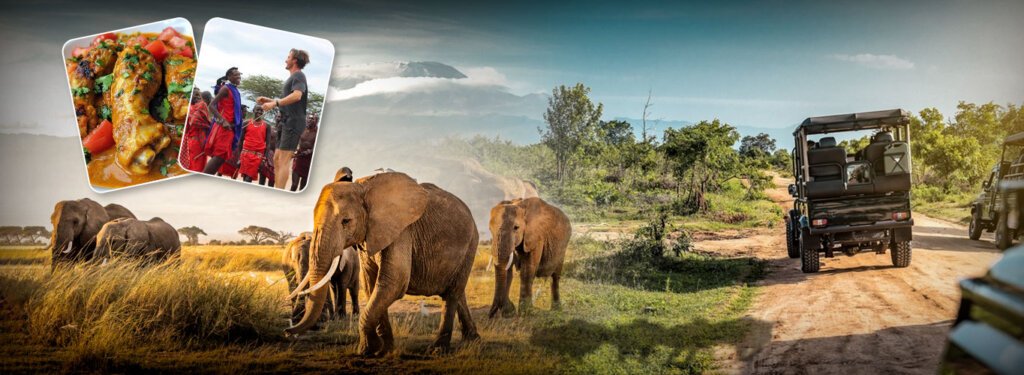
South India's No. 1 Travel Agency ✨
💱 Currency
Kenyan Shilling (KES)
🗣️ Languages
Swahili (National), English (Official)
🌤️ Climate
10°C – 30°C (varies by region and season)
📅 Best Season
June – October (Dry Season & Best for Safaris) January – February (Short Dry Season, Great Wildlife Viewing)
🛡 Must-Know Travel Tips for Visiting Kenya
- 🏧 ATMs are widely available in major cities, but may be limited in rural areas — use machines at airports, banks, and shopping malls for reliability.
- 💳 Credit cards (especially Visa and MasterCard) are accepted in hotels, restaurants, and large stores; however, cash is preferred in smaller towns and markets.
- 🏦 Banks usually operate Monday to Friday, from 8:30 AM to 4:00 PM. Some open on Saturday mornings. Plan withdrawals accordingly.
- 🍷 The legal drinking age in Kenya is 18. Alcohol is available in bars, hotels, and licensed shops.
- 🤝 Kenyans are friendly and respectful. A firm handshake is common. Dress modestly in public, especially in rural and coastal areas
- 💰 Prices vary by season. Peak safari season (July–October) can be expensive; better deals are available during shoulder seasons (March–June, November).
What Is Kenya Famous For? – About Kenya Explained
Kenya is globally renowned for its breathtaking wildlife, vibrant tribes like the Maasai and Samburu, and jaw-dropping natural beauty. The country is synonymous with safari adventures, thanks to its Big Five game—lion, leopard, rhino, elephant, and buffalo—the annual Great Migration, and its many national parks and reserves.
There’s much more to Kenya than just its wildlife.The Great Rift Valley, with its lakes and escarpments, stands as a geological wonder. Mount Kenya is Africa’s second-highest peak and a trekker’s paradise. Kenya’s coastal towns such as Mombasa, Lamu, and Malindi beautifully merge heritage with seaside serenity.In the world of sports, Kenya is celebrated for producing world-class long-distance runners. With so much to offer, it’s no surprise that tourists from across the globe flock here, many through carefully curated Kenya tour packages or custom-made Kenya tour plans.
Kenya Tour Packages
Most Chosen kenya Tour Plans by Our Happy Customers
How Are India and Kenya Connected? – Cultural & Historical Ties
The bond between India and Kenya has evolved over centuries through trade, movement of people, and cultural interaction.During the colonial era, a large number of Indians migrated to Kenya, especially as laborers for the construction of the Uganda Railway. Over time, this community flourished and became an integral part of Kenyan society.
Today, the Indian diaspora in Kenya plays a significant role in the economy, especially in trade and hospitality. Cities like Nairobi and Mombasa have vibrant Indian communities. Indian cuisine is widely popular and festivals like Diwali and Holi are celebrated with enthusiasm. Even Bollywood movies enjoy a loyal following in Kenya. These shared cultural threads strengthen the bond between the two nations and make Indian travelers feel right at home.
Interesting Things to Know About Kenya Before You Go
Before booking your Kenya trip, it’s helpful to understand a few important details about the country. Kenya recognizes Swahili and English as official languages, which makes communication easy for most tourists. The country operates on East Africa Time (EAT), which is two and a half hours behind Indian Standard Time (IST).
The local currency is the Kenyan Shilling (KES). While credit and debit cards are accepted in major cities and hotels, cash is often preferred in local markets, small shops, and rural areas. ATMs are widely available in urban centers, but carrying some local currency is essential, especially for tipping, shopping, or transport in remote regions.
Kenya’s terrain is incredibly diverse—ranging from snow-capped mountains and lush highlands to arid savannas and tropical beaches. The climate also varies: the highlands are cool, coastal areas are warm and humid, while the interior savannahs are hot and dry. Packing layers and sun protection is always a good idea.
A quirky but delightful fact—wildlife like giraffes and zebras can occasionally be seen crossing roads in national parks! This close contact with nature is one of the unique aspects that Kenya tour packages aim to highlight.
It’s also important to know that plastic bags are completely banned in Kenya. Travelers should bring reusable bags for shopping to avoid fines at the airport or local markets—this eco-friendly law reflects Kenya’s strong commitment to environmental conservation.
Travelers planning a Kenya tour plan should also consider the best times to visit. For safaris, travel between June and October; for coastal relaxation, December to March is the prime time.Tailored Kenya tour packages often include ideal itineraries based on the season, with options for wildlife, cultural visits, and coastal relaxation.
Whether you’re going for adventure, nature, or culture, understanding these tips ensures your Kenya tour plan is safe, smooth, and unforgettable.
What to Know Before Booking a Kenya Tour Package:
Booking a Kenya tour package requires careful planning to ensure a memorable and hassle-free experience. First, choose the right time to travel—June to October is ideal for safaris and wildlife viewing, especially the Great Migration in the Maasai Mara. If you prefer fewer crowds and lower prices, consider the shoulder seasons in March–May or November.
Always book your Kenya tour plan with a licensed and reputable tour operator. Verify what the package includes: park entry fees, 4×4 game drives, accommodation (lodges, tented camps, or resorts), meals, internal transfers, and bottled water. Check if the Kenya tour plan offers special experiences like hot air balloon safaris, night game drives, or cultural village visits.
Indian citizens need to apply for an eVisa and should carry a yellow fever vaccination certificate. Travel insurance, insect repellent, and lightweight, neutral-colored clothing are essential. Confirm your Kenya tour plan includes highlights like Lake Nakuru, Amboseli National Park, and Naivasha for a well-rounded experience.
A well-balanced Kenya tour plan typically begins with your arrival in Nairobi, followed by a safari adventure in the Maasai Mara for two days, including game drives and optional hot air balloon rides. The journey then takes you to Lake Nakuru to witness flamingos and rhinos, and onward to Amboseli National Park for breathtaking views of Mount Kilimanjaro before returning to Nairobi for your departure.
Ask about group size, the quality of safari vehicles, and whether your guide is English-speaking. Clarify refund or rescheduling policies. Choosing an operator that supports eco-tourism and local communities adds meaning to your journey.
Which Are the Best Budget Kenya Tour Packages?
Traveling to Kenya doesn’t have to break the bank. There are many affordable Kenya tour packages that deliver world-class experiences at excellent value, especially when booked through reliable Indian or local travel agencies. Whether you’re a solo traveler, a couple, or a family, there’s a Kenya tour plan to suit every budget.
For first-time visitors, a popular and budget-friendly option is the 4-night/5-day Kenya tour package that includes Nairobi and the Maasai Mara. This short and exciting itinerary offers unforgettable game drives, a chance to spot the Big Five, and comfortable stays in quality lodges or tented camps.
Another great option is the 6-night/7-day Classic Kenya Tour, which includes destinations like Lake Naivasha, Lake Nakuru, and Amboseli National Park. This itinerary is perfect for travelers who want to explore Kenya’s lakes, spot flamingos and rhinos, and enjoy stunning views of Mount Kilimanjaro—all while staying within budget.
For those seeking a mix of adventure and relaxation, the Safari and Beach Combo is ideal. This plan typically starts with wildlife safaris in Maasai Mara and Tsavo, followed by a few tranquil days on the sun-kissed beaches of Diani or Watamu. It combines the excitement of wildlife adventures with the tranquility of the coast.Many group tours from India are designed specifically for Indian travelers, often including Indian meals, local Hindi-speaking guides, along with personalized plans for older travelers and those with kids These packages also help with e-visa assistance and provide 24/7 local support during the trip.
Prices for budget Kenya tour packages usually range from ₹85,000 to ₹1,50,000 per person, depending on the season, accommodation quality, and included activities. This typically covers domestic travel within Kenya, park entry fees, guided safaris, meals, and accommodations—but excludes international airfare.
Choosing the right Kenya tour plan not only saves money but also ensures a smooth, enriching, and well-organized travel experience. Budget doesn’t mean compromise in Kenya—it means smart travel with unforgettable moments.
Quick Facts About Kenya – Geography, Wildlife & People
The capital city, Nairobi, blends modern development with rich cultural influence.The country has a population of approximately 55 million people and boasts a diverse topography that includes savannahs, lakes, mountains, and coastal plains. Kenya’s rich wildlife includes elephants, lions, cheetahs, flamingos, and countless other species. Its major ethnic groups include the Maasai, Kikuyu, Luo, and Luhya, each contributing unique cultural heritage.
With over 40 national parks and reserves, including the famous Maasai Mara, Amboseli, Tsavo, and Samburu, Kenya offers one of the best wildlife-viewing experiences on the planet. Several sites in Kenya are UNESCO World Heritage Sites, such as Mount Kenya Forest Reserve and the ancient Swahili town of Lamu.
Kenya Tour Packages
| High season | June to October (Dry Season & Great for Wildlife Viewing), January to February (Short Dry Season) |
|---|---|
| Iconic Attractions | Maasai Mara National Reserve, Mount Kenya, Lake Nakuru, Amboseli National Park, Nairobi National Park, Diani Beach |
| Popular Activities | Safari Game Drives, Hot Air Ballooning over Maasai Mara, Hiking Mount Kenya, Cultural Visits to Maasai Villages, Snorkeling at Diani Beach |
| Visa | E-visa required for most nationalities (including Indian citizens) – apply online before arrival |
| National Animal | African Lion |
| National Flower | Orchid (Kenya has many indigenous orchid species) |
| Famous Food | Nyama Choma (grilled meat), Ugali (maize porridge), Sukuma Wiki (collard greens), Chapati, Mandazi, Kenyan Chai |
Top 10 Reasons Why Tourists Love Visiting Kenya
Tourists are drawn to Kenya for many reasons. The country offers thrilling Big Five safari experiences that are unmatched anywhere else in the world. Between July and October, the Maasai Mara hosts the Great Migration, one of the most spectacular natural events on earth. Kenya’s tribal cultures, especially the Maasai and Samburu, offer visitors a glimpse into ancient customs and traditions.
The country’s stunning beaches along the Indian Ocean make it ideal for relaxation and leisure.The birdwatching opportunities are world-class, with over 1,100 recorded species.With its deserts, mountains, forests, and beaches, Kenya provides stunning scenery for photography lovers.Many Kenya tour packages now include optional experiences like hot air balloon safaris, snorkeling, or cultural visits, allowing travelers to customize their Kenya tour plan for a complete and enriching journey.
When Is the Best Time to Visit Kenya for Safari or Travel?
Kenya can be visited year-round, but the best time to travel depends on your interests and the type of experience you’re looking for.For those planning a wildlife safari in Kenya, June to October offers the best conditions. During these months, rainfall is minimal, vegetation is sparse, and animals gather around water sources—making them easier to spot. This period is also the peak season for the Great Migration in the Maasai Mara, typically taking place between July and October, when millions of wildebeest and zebras cross the Mara River. It’s one of the most spectacular wildlife events on Earth and a major highlight in many Kenya tour packages.
If a beach holiday is on your mind, the best time to relax along Kenya’s coast—especially in Mombasa, Diani Beach, or Watamu—is from December to March, when the weather is warm, sunny, and dry. This season is perfect for swimming, snorkeling, and sunbathing under clear skies.
Birdwatching enthusiasts will find November to April most rewarding, as this is when migratory birds from Europe and Asia arrive, adding to Kenya’s already impressive list of over 1,100 bird species. National parks like Lake Nakuru, Naivasha, and Samburu are birding havens during this time.
However, the long rainy season from April to May is best avoided for safaris, as heavy downpours can make roads muddy and game drives less predictable. Some lodges may also close temporarily during this time.
When creating your Kenya tour plan, consider what you’d like to experience—whether it’s witnessing the migration, enjoying sunny beaches, or exploring nature trails. Reputable travel agencies often design Kenya tour packages around these seasonal highlights, helping you get the best value and most memorable experiences out of your trip.
What Are the Best Things to Do in Kenya?
There is no shortage of incredible things to do in Kenya, a country bursting with natural beauty, wildlife, and cultural richness. A must-visit highlight is the Maasai Mara National Reserve, world-renowned for its thrilling game drives and the annual Great Migration, where millions of wildebeest, zebras, and gazelles thunder across the plains.Few places match Kenya when it comes to spotting the Big Five up close. For adventure seekers, Mount Kenya promises scenic trails and high-altitude thrills. Its snow-capped summits, alpine lakes, and forest trails provide stunning scenery with fewer crowds than Kilimanjaro, making it a peaceful but adventurous experience.
Lake Nakuru dazzles with its pink-hued flamingo population and is also home to white and black rhinos. Nearby, Amboseli National Park offers postcard-perfect views of Mount Kilimanjaro—especially magical at sunrise or sunset—often with herds of elephants walking across the plains.
If you’re short on time, Nairobi National Park offers a unique city-and-safari combo. Just minutes from the capital’s center, this park allows you to see lions, giraffes, and zebras with a city skyline in the background.
For those interested in coastal charm and history, Lamu Island, a UNESCO World Heritage Site, takes you back in time with its winding alleys, ancient Swahili architecture, and dhow boats. Diani Beach and Watamu are ideal for beach lovers, offering white sand, coral reefs, water sports, and tranquil resorts.
Many well-crafted Kenya tour packages include combinations of these destinations, offering a balanced itinerary of wildlife, adventure, culture, and relaxation. Whether you’re looking to explore Kenya’s highlands or unwind by the coast, a thoughtfully planned Kenya tour plan ensures you make the most of your time in this breathtaking country.
What Food Is Kenya Known For? – A Guide to Kenyan Cuisine
Kenyan cuisine is a delightful blend of indigenous traditions, Indian spices, and Arabic culinary influences, making it both flavorful and diverse. One of the most iconic staple dishes is ugali, a stiff maize-flour porridge, typically served with sautéed greens (like sukuma wiki) or hearty meat stews. Nyama choma, which means “roasted meat,” is Kenya’s national favorite—usually goat or beef grilled over open flames and served with kachumbari, a refreshing salad made of onions, tomatoes, and chili.
For vegetarians, sukuma wiki—a dish made from collard greens cooked with onions, tomatoes, and garlic—is not only healthy but widely available. Along the coast, the influence of Indian and Swahili culture shines through in dishes like pilau, biryani, and spicy coconut curries. Indian snacks such as samosas and chapatis are extremely popular across the country, and sweet treats like mandazi (a lightly sweetened fried dough similar to doughnuts) are perfect for breakfast or tea-time.
Fresh tropical fruits such as mangoes, pineapples, and passion fruit are found in abundance, often served in colorful street-side stalls or blended into fresh juices. Coastal areas also offer delicious seafood—grilled fish, prawns, and coconut-infused dishes are highlights for food lovers exploring Mombasa or Lamu.
For Indian travelers, finding familiar flavors is never a problem. Nairobi and Mombasa are home to numerous Indian restaurants offering everything from North Indian curries to South Indian dosas. Many Kenya tour packages even include meal options catering to Indian tastes, ensuring comfort during your culinary journey.
When creating your Kenya tour plan, consider adding a food tour or local cooking class to experience the authentic flavors firsthand. Many local guides can take you to hidden culinary gems—ranging from upscale fusion restaurants to humble street food joints—giving you a well-rounded taste of Kenyan hospitality and cuisine.
Whether you’re a meat lover, a vegetarian, or a spice enthusiast, Kenya’s food scene will leave your taste buds thoroughly satisfied.
Kenya Tour Packages
| Nairobi | Nairobi National Park, Giraffe Centre, David Sheldrick Elephant Orphanage, Karen Blixen Museum, Maasai Market |
|---|---|
| Maasai Mara | Big Five Safaris, Wildebeest Migration (July–October), Hot Air Balloon Rides, Maasai Village Visits |
| Diani Beach (Mombasa Coast) | White Sandy Beaches, Snorkeling, Scuba Diving, Coral Reefs, Skydiving, Luxury Resorts |
| Amboseli | Amboseli National Park, Majestic Views of Mount Kilimanjaro, Elephant Herds, Observation Hill |
| Mount Kenya | Trekking and Climbing, Glacial Peaks, Mount Kenya National Park, Unique Alpine Flora |
| Lake Nakuru | Lake Nakuru National Park, Flamingo Watching, Rhino Sanctuary, Baboon Cliff Viewpoint |
| Lamu Island | CUNESCO World Heritage Town, Traditional Dhow Sailing, Swahili Architecture, Relaxed Coastal Vibes |
What Should Indian Travellers Know Before Visiting Kenya?
For Indian travelers, a trip to Kenya is both exciting and surprisingly accessible. Depending on stopovers and the airline, the journey from India to Nairobi usually ranges from 6.5 to 9 hours.Major carriers like Kenya Airways, Emirates, Qatar Airways, and Ethiopian Airlines offer regular flights from cities such as Delhi and Mumbai.
Currency exchange is best done upon arrival at the airport or through trusted forex centers in major cities. The official currency in Kenya is the Kenyan Shilling (KES).It’s advisable to carry a mix of cash and cards—while credit/debit cards work in most urban establishments, cash is essential for smaller towns, markets, or tips.
Staying connected is easy—buying a local SIM card from Safaricom or Airtel is affordable and ensures you have data and call access throughout your journey. SIM cards are available at the airport or local shops with a passport copy and registration.Most tourist areas and wildlife reserves in Kenya are considered safe for visitors.
However, like any international destination, it’s wise to be cautious in urban areas after dark and avoid displaying valuables openly. When visiting rural communities or tribal villages, dressing modestly and respectfully helps foster goodwill and cultural harmony.
Free Wi-Fi is available in most hotels, safari lodges, and cafes, though connectivity may be limited in remote safari locations.It’s smart to carry a power bank, especially if you’re heading out on extended game drives or visiting remote areas..
Booking Kenya tour packages through Indian travel agencies can add a layer of comfort and familiarity to the journey. Many of these packages include Indian meals, Hindi-speaking guides, and culturally sensitive accommodations—making the travel experience smooth, especially for families or first-time international travelers. A well-organized Kenya tour plan also ensures hassle-free airport transfers, internal travel arrangements, and 24/7 local support.
Whether you’re heading for a wildlife safari, beach holiday, or cultural adventure, these travel tips will help Indian visitors enjoy Kenya to the fullest—comfortably and confidently.
Where to Shop in Kenya – Best Markets & Souvenirs
Shopping in Kenya is an adventure in itself, filled with vibrant colors, authentic craftsmanship, and cultural treasures that tell stories of the country’s rich heritage. Popular souvenirs include Maasai bead jewelry, known for its bold colors and intricate patterns, and kitenge fabrics, which are vibrant, patterned textiles commonly used in clothing and accessories. Hand-carved wooden animal figurines, often representing the Big Five, are favorites among safari travelers. One-of-a-kind Kisii soapstone sculptures, often shaped into animals, bowls, or decorative pieces, make for beautiful keepsakes or gifts.
For the best shopping experience, visit the Maasai Market in Nairobi, a mobile open-air market that rotates locations during the week and offers everything from jewelry and bags to carvings and paintings. The City Market, located in central Nairobi, is great for local crafts and souvenirs under one roof. Old Town bazaars in Mombasa provide a unique coastal flavor, offering Arabic-influenced antiques, textiles, and spices.
Boutiques such as Kazuri Beads, which employs local women to create handcrafted ceramic jewelry, and Kiko Romeo, a high-end fashion brand known for its Afro-fusion style, showcase the best of Kenya’s emerging design scene. Supporting these local artisans also contributes to the country’s community-based tourism economy.
If your Kenya tour plan includes time in Nairobi or Mombasa, make sure to set aside a few hours for shopping. Many Kenya tour packages include stops at artisan markets or allow free time for exploring these colorful, bustling shopping areas. Bargaining is expected in open-air markets, so don’t hesitate to negotiate—it’s part of the cultural experience and often done with good humor.
Whether you’re looking for fashion, home décor, art, or cultural keepsakes, Kenya’s markets and boutiques offer a shopping experience that’s both memorable and meaningful. Adding a shopping excursion to your Kenya tour package ensures you go home not just with photographs but also with authentic pieces of Kenya’s heart and soul.
How Is the Art and Culture Scene in Kenya?
Kenya’s culture is deeply rooted in its many ethnic communities, each with their own language, dress, music, and customs. The Maasai are known for their jumping dances and colorful attire, while the coastal Swahili culture reflects Arabic and Islamic influences. Traditional music, dance, and storytelling remain important cultural expressions.
In Nairobi, modern art is on the rise, with galleries like the Nairobi Contemporary Art Institute showcasing local talent. Kenya’s music scene is vibrant and diverse, from Afrobeat to traditional Benga rhythms. Literature and film are also thriving, with events like the Kalasha Film Festival gaining international attention. To make the most of these cultural experiences, travelers can opt for Kenya tour packages that specifically include local art and heritage elements as part of their Kenya tour plan.















